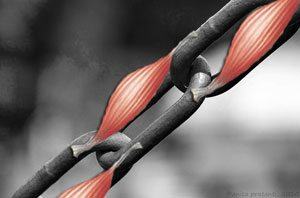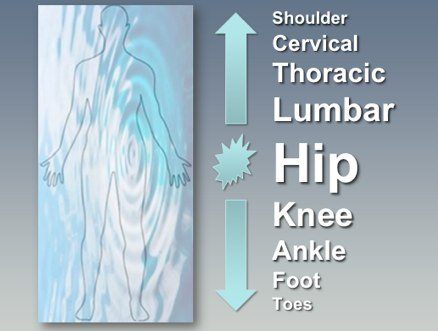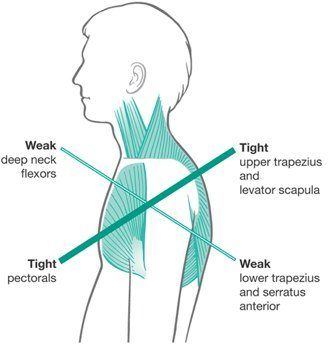I remember when I first heard about the kinetic chain concept when I was in undergraduate physical therapy school. It was the first introduction to the concept that joints in the body can be causing dysfunction elsewhere. Simply put, brilliant. We just spent the last year talking about anatomy and physiology and learning how to evaluate a joint. Now we realize that while we do have to evaluate the joint, the answer probably lies elsewhere!
[quote]A chain is only strongest as its weakest link.[/quote]
The last two decades or so has really seen a large push towards understanding human movement and dysfunction. We have made many significant breakthroughs in understanding things such as:
- How the scapular influences the glenohumeral joint
- How pelvic tilt influences the thoracic spine, scapula, and shoulder
- How the hip and foot influences the knee
This is obviously just a small glimpse into these concepts, and there have been many more, but I remember learning about treating the symptoms of patellofemoral pain and how “challenging” these patients were. Well, I would agree, if we all just simply treated the location of the symptoms rather the the source of dysfunction. To me that is really always our goal:
[quote]Treat the source of dysfunction rather than the location of symptoms[/quote]
The Problem with the Kinetic Chain Concept
Just like anything else, the more I experienced and the more I learned, I realize that my original understanding of the kinetic chain concept was probably not ideal. There were two important pieces that I had originally not fully grasped, but feel like I better understand now.
Not all Links in the Human Body Kinetic Chain are Equally as Important
The first thing that I quickly realized was that unlike the actual “chain” analogy, where if you break one link, the chain is pretty useless, the human body did not act this way. Not every link in the kinetic chain is equally as important. How many times have we heard about a story about someone that stubbed their toe and then started having contralateral shoulder problems?
While I agree this MAY be possible… I get it. You limp, change your gait, changes your hip, pelvis, spine , scapular, and whammy you hurt your shoulder. This CAN happen. But this is pretty extreme to me and the person probably had some underlying issues going on prior to the dreaded stubbed toe incident that drastically altered the course of the rest of their life.
That stubbed toe can have a huge impact, but I would say it’s biggest impact is actually at the joints closest to it, the rest of the foot and ankle. Those areas are going to be influenced by the stubbed toe a lot more than the shoulder.
This is why I like to think of the kinetic chain as more of a ripple in water than an actual chain. So, not a chain, but a chain reaction. I have talked about the kinetic chain ripple effect in the past, but in general, the joints closest to the area of dysfunction are going to be most impacted. Take the hip as an example. Any tightness, weakness, or imbalance of the hip is going to have a large influence on the low back and knee, and a much less impact on joints the further away you get from the hip.
Here is a slide I just recently used during my Functional Stability Training seminar:
This may not change your thought much, but it does impact the way I evaluate. Using this concept, I always start from the center of the ripple and branch outward from there. Using this method, you will find the areas of imbalance and dysfunction that are having a large influence on the area of pathology. Basically, work from the center outward. Once you address areas closest, re-evaluate and assess if the problem is better or if you need to move further away in the kinetic chain.
The Kinetic Chain Needs to Include what is Between Each Link
 The other big omission I often see people make when considering the kinetic chain is that they think of each link in the chain as a joint. This is a simplistic version of the kinetic chain in purely the sense of biomechanics an arthrokinematics. Instead, realize that there are many influence on the kinetic chain between each joint.
The other big omission I often see people make when considering the kinetic chain is that they think of each link in the chain as a joint. This is a simplistic version of the kinetic chain in purely the sense of biomechanics an arthrokinematics. Instead, realize that there are many influence on the kinetic chain between each joint.
[box]This includes the muscles, fascia, ligaments, tendons, and anything else you can think of. Basically, it’s not just the joints, but also everything in between.[/box]
We have made great strides in this area over the last decade, especially with concepts like Myers’ Anatomy Trains, Stecco’s Fascial Manipulation, Sahrmann’s Movement Impairment Syndromes, and Cook’s Functional Movement. (Photo by pratanti)
The kinetic chain shouldn’t be just how the neck influences the shoulder, which influences the elbow, which influences the wrist. It should be all encompassing include things such as how:
- Serratus anterior weakness influences subacromial impingement
- The plantar fascia influences the Achilles tendon and calf
- The psoas influences patellofmoral biomechanics
- Pec minor tightness influences lower trapezius weakness
A joint doesn’t have to just influence a joint and a muscle influence a muscle. All these structures work and interact together. A great example of this is the upper body cross syndrome.
This is a great example of how both tightness and inhibition influence different areas around a joint. This is the real kinetic chain concept. Not simply joint to joint, but structure to structure. Something to consider next time we think about how the body functions and how motion is achieved. These factors related to the kinetic chain concept should be applied when discussing functional movements.






